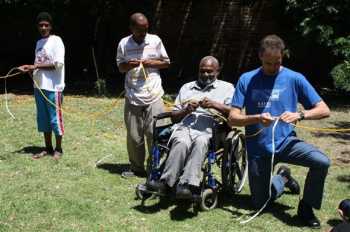BirdLife South Africa's Seabird Division is working with the Ocean View Association for Persons with Disabilities to make bird-scaring lines for use in the South African fishing industry.
"In just under a year the centre has produced over 65 bird scaring lines which are used in both the longline and trawl fisheries. It takes the small team of ten people just over an hour to construct one line. A variety of materials are used to create the lines including cable ties, garden hose, rope and plastic strapping."
This project is a "win-win" one: it brings much-needed employment and a sense of achievement to a group of physically disabled people in a poor community which has a high level of unemployment - and also helps save seabirds from being hooked on longlines or killed by trawl warps.

Ross Wanless, BirdLife South Africa (on the right), helps the team from the Ocean View Association build a bird-scaring line
Photograph courtesy of BirdLife South Africa's Seabird Division
Click here to read more about the scheme.
Perhaps this type of project could be extended to other developing countries that have both the need to alleviate poverty and a seabird bycatch problem?
John Cooper, ACAP Information Officer, 24 June 2012

 English
English  Français
Français  Español
Español